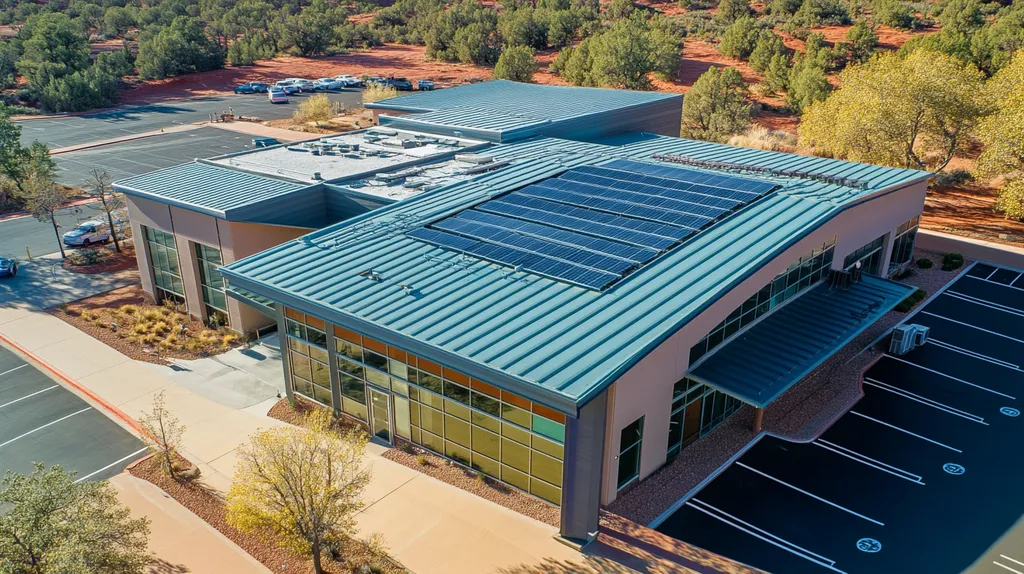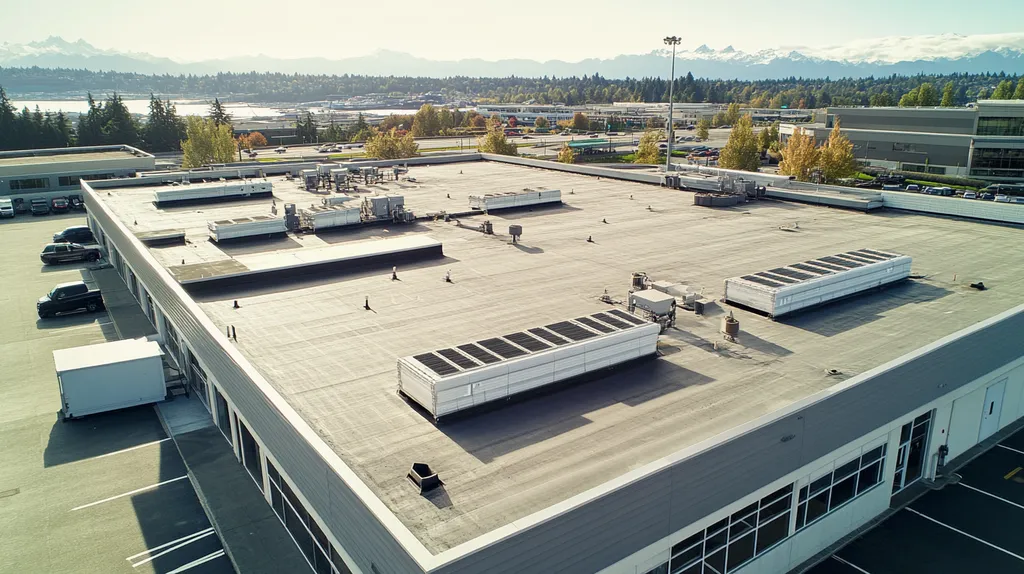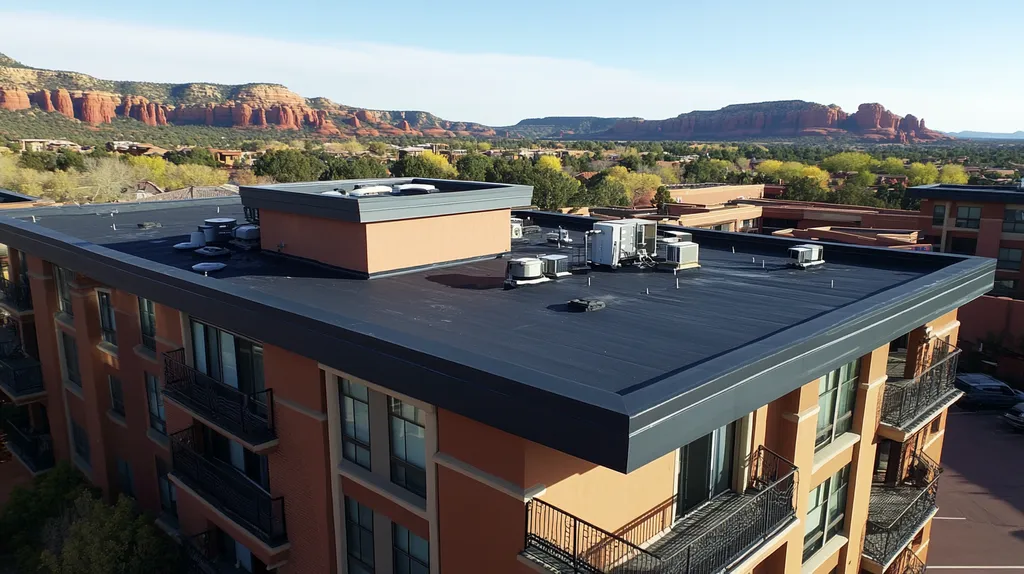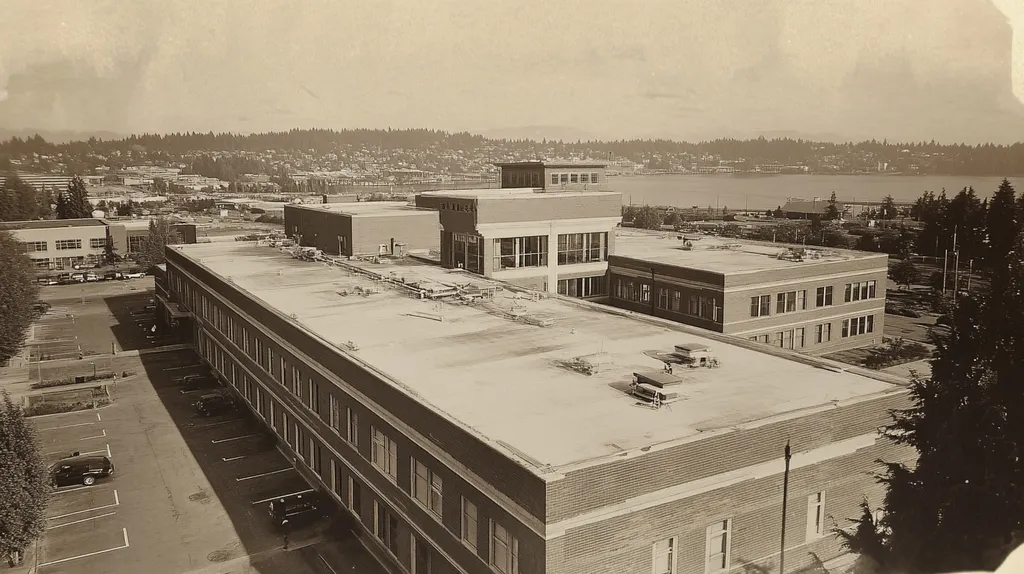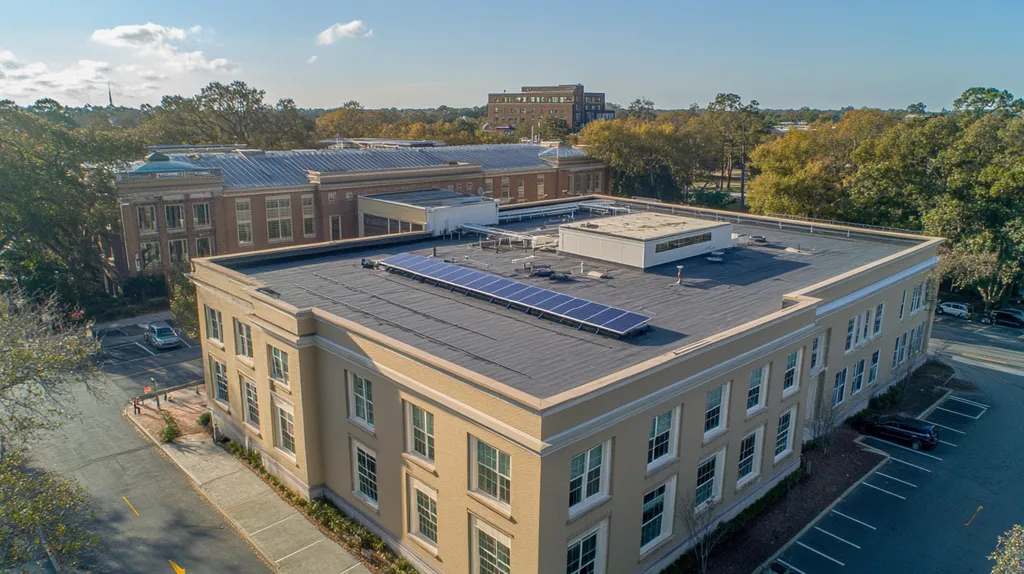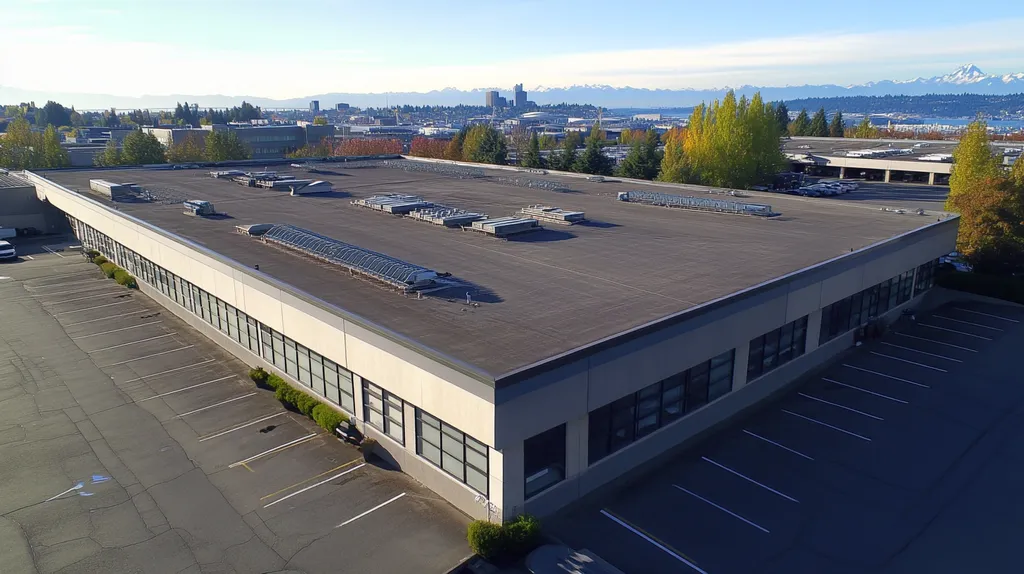Recent studies reveal that 73% of commercial roof failures stem from inadequate coating materials or improper safety protocols during application. These preventable issues cost facility owners over $2.8 billion annually in repairs and liability claims.
For facility managers, navigating the complex landscape of roofing safety regulations has become increasingly critical as oversight intensifies and environmental standards evolve.
This comprehensive guide examines essential coating safety requirements across performance, financial, compliance, and risk management domains, providing actionable solutions to protect both personnel and property investments.
SECTION 1: PERFORMANCE FACTORS
Coating selection for commercial roofs is a critical decision with immediate implications. Incorrect choices can lead to significant issues, as nearly 80% of roofing problems arise from material inadequacies or installation mishaps. For facility managers, navigating the myriad of coating options while ensuring compliance with safety regulations is essential for optimizing both performance and longevity.
Coating Material Selection
Selecting the appropriate coating material is crucial for safety and effective performance. Options like elastomeric and polyurethane coatings vary in durability and flexibility, requiring facility managers to assess them based on their roof type and environmental conditions.
Subpar coatings not only violate industry standards but can also lead to leaks and accelerated roof degradation. By recognizing each building’s unique requirements, managers can make informed material choices that ensure long-lasting protection.
High-quality coatings provide enhanced defense against UV rays and severe weather, significantly extending a roof’s lifespan. Staying updated on coating technology advancements is vital; selecting compliant materials helps mitigate risks associated with roof replacement costs.
Key Action Items
Energy Efficiency Standards
Meeting energy efficiency standards is increasingly vital for roof coating choices. Many regulations specify reflectivity and emissivity values designed to minimize energy consumption within buildings, which helps combat the urban heat island effect and boosts sustainability.
Selecting coatings that meet or exceed these standards can significantly reduce utility expenses. For example, using white or reflective coatings can lower cooling costs within commercial buildings, promoting ongoing savings.
Facility managers are encouraged to stay informed about evolving energy codes, as compliance not only ensures safety but also increases a building’s desirability for tenants or buyers. Energy-efficient coatings may even open doors for financial incentives, further underscoring their importance in roofing strategies.
Key Action Items
Thermal Resistance Impact
The thermal resistance of roof coatings is a key performance factor that affects both energy efficiency and tenant comfort. Coatings with higher R-values excel at reducing heat transfer, significantly enhancing indoor climate stability.
By incorporating coatings that offer superior thermal resistance, buildings can maintain enjoyable temperatures year-round, reducing dependence on heating and cooling systems. This not only boosts comfort for occupants but can also lead to energy savings.
Moreover, adequate thermal protection plays a crucial role in prolonging roof lifespan. Coatings that fail to deliver necessary thermal resistance contribute to premature wear and steep maintenance expenses. By emphasizing thermal resistance, facility managers can align safety regulations with optimized roof performance and financial efficiency.
Key Action Items
SECTION 2: FINANCIAL CONSIDERATIONS
Grasping the financial implications of roof coatings is essential for commercial property owners and facility managers. From the wide range of material costs to installation expenses, making the wrong choice can lead to unwanted financial surprises. A poorly applied coating can escalate repair and maintenance costs in the long run. This section delves into the costs of materials, installation labor, and potential long-term savings associated with choosing the right rooftop coatings.
Cost of Coating Materials
The price of coating materials varies greatly based on type and quality. While high-quality coatings may mean a higher upfront cost, they often offer superior durability and performance. For instance, investing in a silicone coating might seem pricey initially, but it can significantly extend the roof’s lifespan.
It’s crucial to assess the specific needs of the building when selecting materials. A poor material choice not only jeopardizes the effectiveness of the coating but could also introduce safety risks. Consider factors such as the local climate and roof design to guide material selection.
Obtaining multiple quotes from reputable suppliers helps ensure competitive pricing. This allows for informed budgeting while keeping a watchful eye on cost and performance, ultimately safeguarding against unforeseen expenses and safety concerns.
Key Action Items
Installation Labor Expenses
Labor costs for installation often comprise a significant portion of the overall coating investment. The expertise of skilled labor is crucial, as proper application becomes even more critical with roof complexity. For instance, flat roofs often require distinct handling techniques compared to sloped roofs.
Hiring experienced professionals not only ensures accurate application but also adherence to vital safety regulations, which can help avoid fines and extra costs for retrofitting. Therefore, investing in skilled labor is not just a financial decision but also a necessary safety measure.
Timing for installation is another key factor. Rushed work can lead to mistakes, resulting in issues such as blistering or peeling. A carefully managed installation process helps reinforce safety compliance and operational efficiency.
Key Action Items
Long-Term Cost Savings
Investing in quality roof coatings can yield significant long-term cost savings. Even though the initial investment may appear high, these coatings can greatly enhance the roof’s durability and minimize leakage and repair costs in the future.
For example, reflective coatings can cut energy costs by reducing heat absorption, leading to lower air conditioning expenses and substantial savings over time. Furthermore, a roof that lasts longer means less frequent replacement, translating to even more financial relief.
Facility managers should also consider how high-quality coatings can influence overall building value. A well-maintained roof not only increases marketability but can also enhance resale value, making the property a more attractive asset for buyers.
Key Action Items
SECTION 3: COMPLIANCE REQUIREMENTS
Adhering to safety regulations for roof coatings is essential for safeguarding both workers and property investments. Non-compliance can trigger substantial penalties, including fines and work slowdowns that could impact business operations. Therefore, facility managers must be proactive in keeping abreast of changing regulations to maintain smooth operations. This section highlights the importance of regulatory updates, enforcement of safety standards, and environmental compliance.
Regulatory Updates Overview
Roofing regulations continually evolve, making it vital for facility managers to stay informed. Guidelines from organizations such as OSHA and the EPA are frequently updated, influencing the practices and standards applicable to roof coatings. Regularly reviewing these changes helps avoid regulatory missteps that can disrupt operations.
Recent updates have introduced stricter limits on VOC (volatile organic compounds) in roofing materials. Compliance with these regulations not only fosters a safer working environment but also benefits the company’s reputation. Choosing compliant products not only mitigates risks but also enhances operational credibility.
Ignoring regulatory changes may lead to project delays and additional expenses. Partnering with certified roofing contractors who understand the latest requirements can simplify compliance and ensure all work aligns with current standards. Staying informed is not just advisable; it is essential for operational success.
Key Action Items
Safety Standards Enforcement
Enforcing safety standards during roofing projects is a major responsibility for facility managers. Complying with safety protocols is not only a legal requirement but also strengthens the overall safety culture within the organization. Regular training on safety practices can significantly lower accident risks.
Ongoing assessments and audits of roofing operations are crucial. Conducting frequent checks can help ensure adherence to safety standards and identify hazards before they lead to incidents. This proactive approach promotes safety and enhances workplace conditions.
For instance, appointing a dedicated safety officer for roofing projects can provide essential oversight, ensuring compliance with rigorous safety measures. Upholding high safety standards cultivates better project outcomes and boosts employee morale, creating a win-win environment.
Key Action Items
Environmental Compliance
Environmental regulations have become increasingly critical in the roofing sector. Facility managers must ensure that roofing products not only comply with quality standards but also minimize their environmental impact. This requires a commitment to using materials that meet strict environmental criteria.
Using coatings that contain harmful chemicals can result in significant environmental and legal repercussions. Adopting eco-friendly materials, such as those with low VOC emissions, can help mitigate these risks while supporting sustainable business practices.
Incorporating green roofing practices not only adheres to environmental regulations but can also boost energy efficiency. For example, implementing green roofs can enhance insulation and decrease energy costs. Making these forward-thinking choices reflects a commitment to sustainability, benefiting both the business and the surrounding community.
Key Action Items
SECTION 4: RISK MANAGEMENT
Ensuring safety regulations for roof coatings is not just about compliance; it’s essential for creating a secure working environment. Statistics indicate that falls account for over 30% of workplace fatalities. By implementing effective risk management strategies, including fall protection, heat stress mitigation, and fire safety measures, facility managers can protect workers and uphold safety regulations.
Fall Protection Strategies
Implementing fall protection strategies is critical for any commercial roofing project. OSHA mandates that proper fall protection must be provided when workers are at risk of falling six feet or more. Options such as guardrails, safety nets, or personal fall arrest systems play a major role in accident prevention.
Regular inspections of fall protection systems are vital to ensure their effectiveness. Facility managers must prioritize these checks to avoid accidents and fines. Moreover, providing training on fall hazards and proper equipment use strengthens the safety culture of the organization.
Temporary anchor points during the installation of liquid coatings serve as crucial safety measures. These points should be secured and regularly tested to maintain safety compliance. Establishing clear communication among onsite personnel enhances teamwork in identifying potential hazards and reinforcing safety protocols.
Key Action Items
Heat Stress Mitigation
Heat stress poses significant risks on commercial roofs, especially in warmer climates. Thousands of workers are affected by heat-related illnesses each year, negatively impacting their productivity and health. Proactive measures are essential to reduce these risks.
Creating work protocols such as frequent breaks, hydration stations, and shaded areas can help alleviate heat stress. Facility managers should monitor weather conditions and adapt work schedules to avoid peak heat times.
Training employees to recognize signs of heat stress is a critical element in preemptive action. Additionally, leveraging technology, like wearable devices that monitor body temperature, can provide real-time feedback and timely interventions.
Key Action Items
Fire Safety Measures
Fire safety is a vital component of risk management in roofing projects. The use of flammable materials and inadequate safeguards increase the risk of fire incidents. Facility managers must ensure compliance with fire safety regulations and codes.
Installing fire-resistant coatings can help prevent flames from spreading effectively. It’s equally important to develop a fire response plan and conduct regular fire drills to prepare for emergencies.
Hiring professional contractors familiar with fire safety standards minimizes risks. They can provide best practice insights and ensure that materials used meet regulatory requirements. Furthermore, ensuring access to fire-fighting equipment, such as extinguishers, must be a priority.
Key Action Items
SECTION 5: OPERATIONAL PROCEDURES
Prioritizing safety during roofing coating applications is vital for protecting workers and preserving valuable building assets. With falls, slips, and equipment mishaps leading to 85% of workplace injuries in construction, facility managers must enforce rigorous operational procedures. This section details essential steps, including pre-application inspections, best practices during application, and post-application maintenance, all designed to ensure a safe working environment and enhance coating longevity.
Pre-Application Inspections
Before applying any coating, a thorough inspection of the roofing system is essential. This step confirms that the surface is clean, dry, and free from debris, moisture, and existing damage, all of which could jeopardize the coating’s performance.
Facility managers should also look for loose materials, rust, or previous coating failures. Addressing these issues in advance will not only prevent complications later but also improve the durability of the new coating.
Weather conditions play a crucial role in successful coating application. Scheduling work during favorable weather is essential, as adverse conditions can result in adhesion issues or coating failures.
Key Action Items
Coating Application Best Practices
Following established best practices during the coating application is crucial to ensure both safety and high performance. All workers should wear appropriate personal protective equipment (PPE), such as hard hats and slip-resistant footwear, to reduce risk levels.
Leveraging modern equipment, such as airless spray systems, can enhance safety and efficiency, mitigating exposure to harmful fumes and creating a safer work environment.
It’s important that teams are thoroughly trained on the specific materials used, as different coatings may have unique application requirements regarding curing times and ambient conditions. Effective communication among team members fosters prompt identification and resolution of any issues.
Key Action Items
Post-Application Maintenance
Once the coatings are applied, ongoing maintenance is critical to ensure their long-term effectiveness. Facility managers should implement a regular inspection schedule to monitor the roof for signs of wear, damage, or degradation.
Periodic cleaning of the coated surfaces is essential. It prevents debris and pollutants from accumulating, which can undermine the coating’s integrity and lead to costly repairs.
Maintaining thorough documentation of all maintenance activities is beneficial, enabling managers to identify trends indicative of potential problems. Establishing a safety protocol for maintenance tasks, including lockout/tagout procedures, is vital for protecting personnel working on the roof.
Key Action Items
SECTION 5: OPERATIONAL PROCEDURES
Ensuring safety during the application of roofing coatings is vital for protecting both workers and building assets. A staggering 85% of workplace injuries in construction stem from falls, slips, and equipment mishaps. Facility managers must implement rigorous operational procedures to mitigate these risks. This section outlines essential steps, from pre-application inspections to proper maintenance post-application, that will safeguard personnel and property.
Pre-Application Inspections
Prior to any coating application, a thorough inspection of the roofing system is critical. This step ensures that surfaces are clean, dry, and free from debris, moisture, and any damage that could undermine the coating’s effectiveness.
Facility managers must check for loose materials, rust, or signs of previous coating failures. Addressing these issues beforehand can prevent complications and enhance the longevity of the new coating.
Additionally, assessing weather conditions is essential. Applying coatings during adverse weather can result in poor adhesion and failures, making scheduling vital.
A detailed checklist for pre-application inspections should be utilized to maintain consistency and proper documentation. This systematic approach enhances safety and operational efficiency, reducing the likelihood of unanticipated delays.
Key Action Items
Coating Application Best Practices
Following best practices during the coating application is essential for safety and performance. All workers should wear appropriate personal protective equipment (PPE), including hard hats and slip-resistant footwear, to minimize risks.
Utilizing modern equipment, such as airless spray systems, can enhance both safety and efficiency. These systems reduce exposure to harmful fumes, fostering a safer work environment.
It is crucial for teams to be trained on the specific materials being used, as different coatings have unique application requirements. For instance, some coatings necessitate specific curing times and ambient conditions to bond properly.
Maintaining regular communication among team members is vital to promptly identify and address challenges. Establishing a clear chain of command helps ensure any issues are reported immediately, upholding safety protocols throughout the process.
Key Action Items
Post-Application Maintenance
Once coatings are applied, ongoing maintenance becomes essential for long-term performance. Facility managers should implement a regular inspection schedule to monitor the roof for signs of wear, damage, or degradation.
Cleaning the coated surface periodically helps prevent the accumulation of debris and pollutants that can compromise the coating’s integrity. This maintenance not only extends the life of the roof but also ensures a safer environment for maintenance personnel.
Thoroughly documenting maintenance activities provides a valuable history that allows managers to spot trends indicating underlying issues. This proactive approach can significantly mitigate future repair costs and operational disruptions.
Incorporating safety protocols for maintenance operations, including lockout/tagout procedures, further enhances site safety. Training all personnel in these practices is vital to ensure compliance and security around the roof area.
Key Action Items
The Bottom Line
With commercial roofing safety violations resulting in over $2.5 million in OSHA fines annually, facility managers cannot afford to overlook coating safety regulations.
The growing complexity of compliance requirements, coupled with advancing coating technologies, demands a systematic approach to safety protocol implementation.
Environmental regulations continue to tighten, with new VOC restrictions and energy efficiency standards reshaping coating selection criteria.
Successful coating projects require a three-pronged focus: rigorous safety protocols, proper material selection, and meticulous documentation of compliance measures.
By following the actionable solutions outlined in this guide, facility managers can create safer working environments while protecting their property investments and avoiding costly regulatory penalties.
FREQUENTLY ASKED QUESTIONS
Q. What factors influence coating selection for commercial roofs?
A. Factors influencing coating selection include roof type, environmental conditions, and material durability. Selecting appropriate coatings ensures compliance with safety regulations and prolongs the roof’s lifespan. It’s essential to evaluate each building’s unique requirements to make informed decisions.
Q. How do labor expenses affect commercial roof coating costs?
A. Labor costs can significantly impact the total expenditure on roof coatings. Hiring skilled labor ensures proper application and adherence to safety regulations. Professional installers may cost more upfront but reduce the risk of errors and future expenses associated with poor application.
Q. Why is it important to keep up with regulatory updates for roof coatings?
A. Staying informed about regulatory updates is crucial to avoid penalties and ensure safety. New guidelines often set strict limits on VOCs and other safety standards, impacting the materials you can use. Compliance not only fosters a safe environment but also enhances your company’s reputation.
Q. What are effective risk management strategies for commercial roofs?
A. Effective risk management includes installing fall protection systems and strategies for heat stress and fire safety. Training workers to recognize hazards and implementing regular safety audits are also essential. Proactively addressing these risks protects employees and maintains compliance with safety regulations.
Q. How do operational procedures enforce safety during coating applications?
A. Implementing operational procedures ensures that safety is prioritized during coating applications. Pre-application inspections and employee training on best practices promote a safe working environment. Regular documentation of safety measures also helps track compliance and identify areas for improvement.
Q. What maintenance is required after applying roof coatings?
A. Post-application maintenance includes regular inspections for wear and prompt cleaning to prevent debris buildup. It’s critical to document maintenance activities to identify trends and manage risks effectively. Establishing safety protocols for ongoing maintenance ensures the safety of personnel working on the roof.
Q. What types of coatings are recommended for energy efficiency on roofs?
A. Recommended coatings for energy efficiency include reflective and cool coatings that minimize heat absorption. These enhance indoor climates while lowering energy costs, making your building more environmentally friendly. Choosing energy-efficient materials can also provide financial benefits through utility savings and potential incentives.

